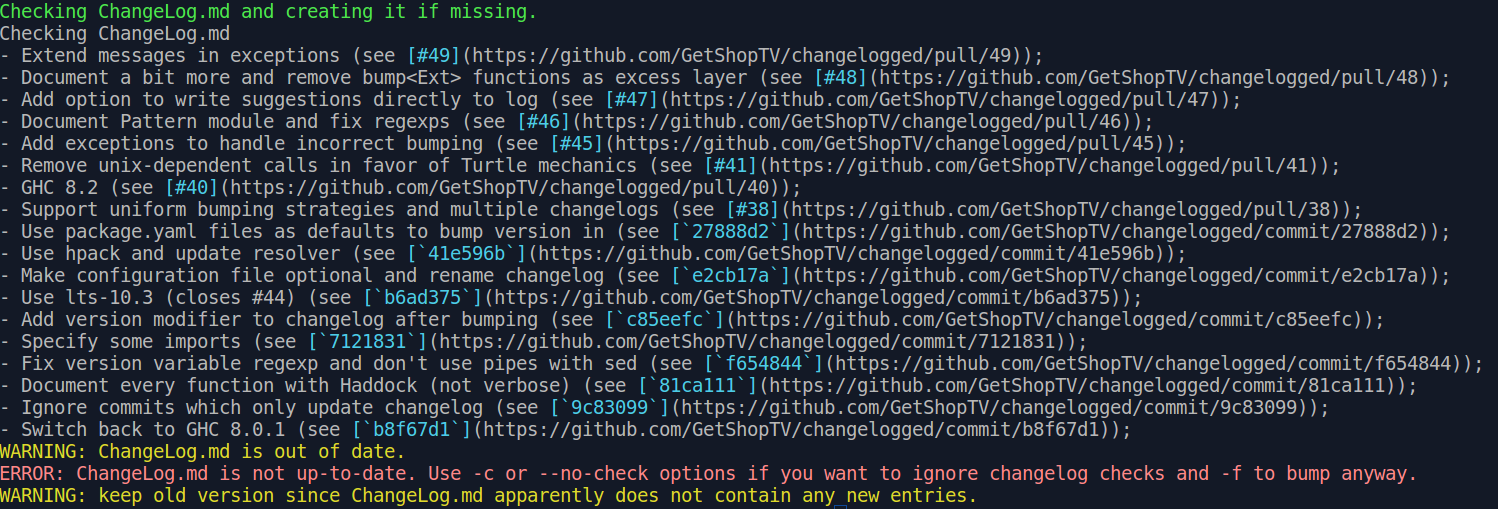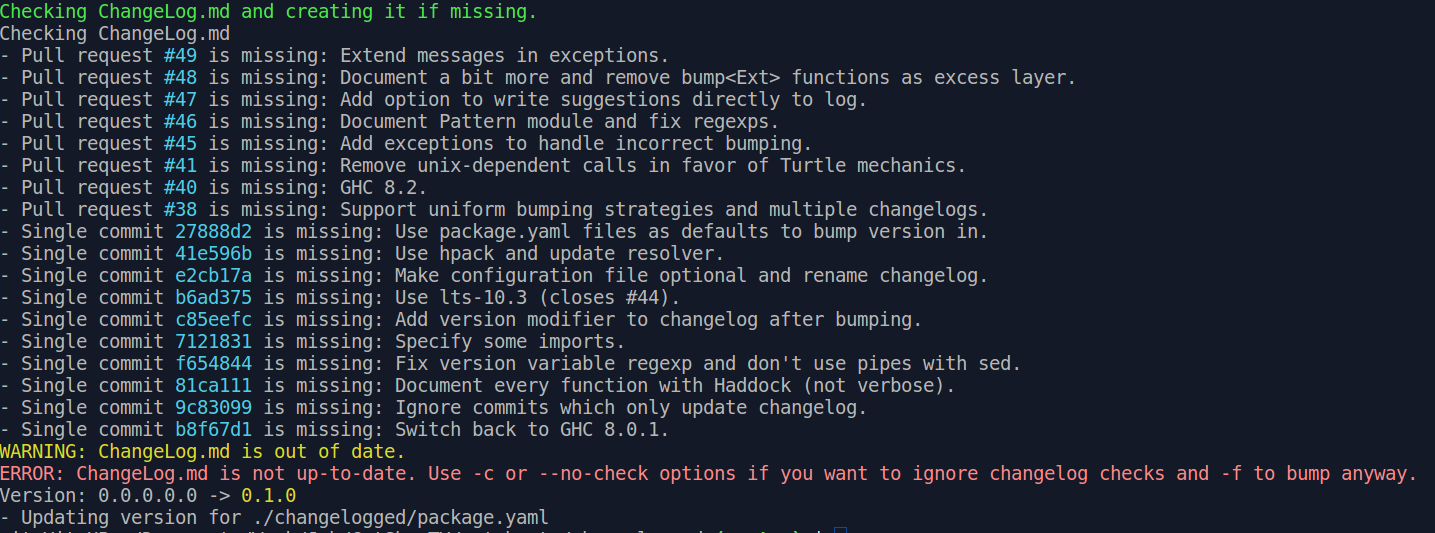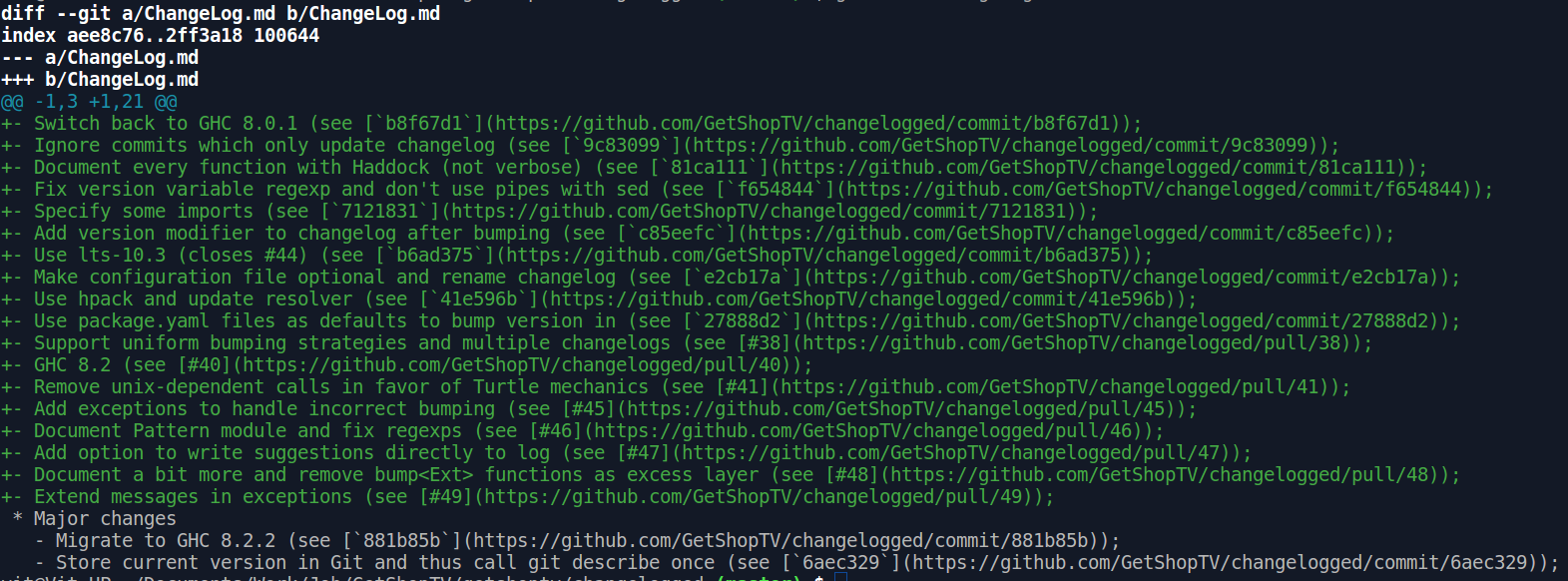Changelog manager for Git projects.
Please see the README on Github at https://github.com/GetShopTV/changelogged#readme
changelogged
What and how to?
Purpose
This is the tool for tracking project history and release documentation. It guides developer through writing changelogs are bump version in project files. With proper usage it guarantees that every pull request or commit from git history is mentioned in project changelogs and that versions all over the project are up to date. It can also write changelogs based on git history and infer new version from changelog if it contains rubrication by level of changes.
Configuration file
changelogs:
main:
# You can simply use arrays here.
path: "CHANGELOG.md"
api:
path: "API_CHANGELOG.md"
indicator:
path: "file.json"
variable: "version"
versioned:
main:
- path: "file.cabal"
variable: "version"
- path: "file2.cabal"
variable: "version"
- path: "file3.hs"
variable: "version"
- path: "file4.json"
variable: "version"
api:
- path: "file.hs"
variable: "apiVersion"
- path: "file.json"
variable: "version"
Config is optional. With no config tool will try to check file named ChangeLog.md as far as it's part of Stack project template and bump versions in package.yaml files all over the project.
Config (named changelogged.yaml) is split in two sections.
changelogs record contains records about each changelog to track. Each changelog has a key - key of the record. Two keys are reserved - main and api for common project changelog and API changelog correspondingly. For each key there is a value. path is path to changelog from directory where you intent to run changelogged. indicator is optional. indicator is used e.g. for API changelogs - it's file such that changing this file is equivalent to change API. This record contains path to file and variable where version is stored. Current version for parts tracked by local changelogs is known from indicator. That's why variable key persists. General version of project is known from latest git tag.
versioned section contains same key-names as changelogs. Each key contains array of files with path to file and variable where version is stored.
Features reference
Help message
changelogged --help
changelogged - Changelog Manager for Git Projects
Usage: changelogged [--format FORMAT] [--update-changelog] [--bump-versions]
Available options:
-h,--help Show this help text
--format FORMAT Missing entries report format. FORMAT can be 'simple'
or 'suggest'. (default: simple)
--update-changelog Prepend missing entries to changelogs. Available with
--format=suggest.
--bump-versions Bump versions according to change level.
--level CHANGE_LEVEL Level of changes (for packages). CHANGE_LEVEL can be
'app', 'major', 'minor', 'fix' or 'doc'.
--api-level CHANGE_LEVEL Level of changes (for API). CHANGE_LEVEL can be
'app', 'major', 'minor', 'fix' or 'doc'.
--from-bc Check changelogs for the entire history of the
project.
--force Bump versions even when changelogs are outdated.
--no-check Do not check changelogs.
See examples below
Checking changelogs
This is default feature. Changelogged will output all missing pull requests and commits with their messages. It ignores commits and pull requests affecting only .md files.
You can skip it with -c option or ignore results with -f option. Also you can check changelog from the first commit with -e.
Bumping versions
This is also default feature. In default way if changelogs are up to day changelogged will bump versions all over the project.
You can variously combine changelog checking and bumping versions. For example you may just want to be sure changelogs are up to date. There is -C option for that. By default new version is inferred from changelog. It will work if you have some of * App...* Major..., * Minor..., * Fix..., and * Doc... sections in changelog and name versions correspondingly. Suggested versioning: app.major.minor.fix.doc. Otherwise you can specify new version explicitly with -l option. It's also the only way to work with -c option.
Multiple changelogs and subversions
This feature requires changelogged.yaml.
With -m option tool will assume there is more than one changelog and check all of them by keys from configuration file. Here is also subversioning from the box. Current version is known from indicator file and new version is known from changelog.
You cannot explicitly set new version for arbitrary changelog but -W option provides special checking of API changelog. And you can set new version with -a. It's impossible to check only API changelog for now. See issue.
Writing changelogs.
--format suggest provides another format for records you see on the screen. It can be used with -y option to write these strings to the top of changelog they are relevant to. This option cannot be used with --format simple which is default.
Guiding examples:
Common run:
changelogged (master):$ changelogged

Suggest changelog entries:
changelogged (master):$ changelogged --format suggest

Force with no entries in changelog:
changelogged (master):$ changelogged --format suggest -f

Force with explicit version:
changelogged (master):$ changelogged -f -l major

Write suggested entries to changelog (works only with --format suggest)
changelogged (master):$ changelogged --format suggest -y

changelogged (master):$ git diff ChangeLog.md
 It requires some manual editing after. And it will not bump version immediately.
It requires some manual editing after. And it will not bump version immediately.
Bump version infering it from changelog:
changelogged (master):$ changelogged --format suggest -y

changelogged (master):$ git diff ChangeLog.md

Do not bump even if changelogs are up to date
changelogged -C

Try to bump without checking changelogs. Seems that -f option is always preferrable. But it waits for use cases.
chagelogged -c

Typical daily workflow to keep project and API changelogs up to date (assuming existing changelogged.yaml):
See missing entries:
changelogged -C --format suggest -W
Record these changes.
changelogged --format suggest -W -y
And then edit changelogs manually.
Suggested simple workflow on release (for project with no changelogged.yaml and API changelog):
See missing entries:
changelogged -C
Record these changes:
changelogged --format suggest -y
Manually edit changelog
Bump versions:
changelogged
Next part is subject to change:
Commit files with bumped versions.
Record commit with version bumps:
changelogged --format suggest -y
Edit changelog - move new entry under version milestone. Note: changes in .md files are ignored.
Commit changelog, push and release.
Setting up
Requirements
It works with git projects only. It was never tested on Windows. Ideally it will work if you have Git Bash installed. As tool was designed for Haskell ecosystem first there are these extensions supported: .hs, .cabal, .yaml and .json. You cannot bump version in any other file. But new extensions can be easily provided as far as changelogged aims to have the most wide users community. See Add new extension section.
Getting and building
First of all you should go to project Github
Then you can simply download it - there is a binary in bin directory. After execute something like cp bin/changelogged ~/.local/bin.
Or you can clone repo and build it from source. You need latest Stack installed. To build run
stack install
Contributing
Common
Bug reports and feature requests are welcome on Github
You are free to fork project and make a pull request.
Add new extension
You may want to use this tool inside project written not in Haskell. You are very welcome.
Version bumping is restricted with extension of file. There is no euristic rules like "version is placed in version = " to have determined behaviour. You may request for extension you want to be supported in special issue. It will be here ASAP. Or you may write it yourself. You are welcome to ask about how in comments in that issue (or browse comments).
